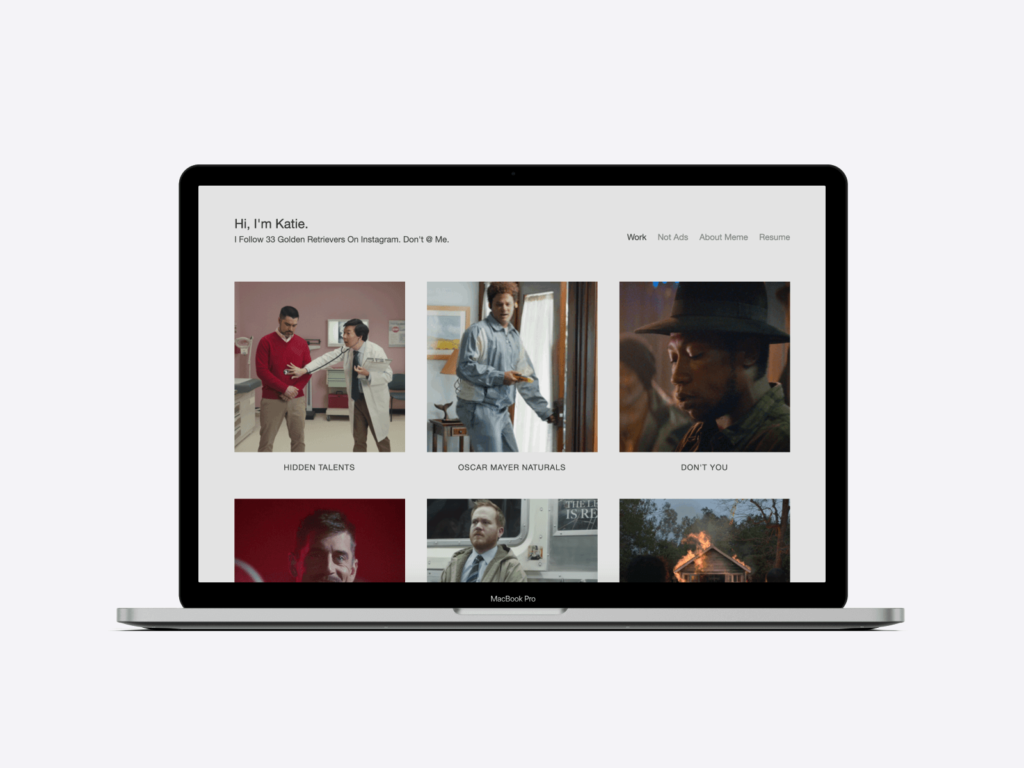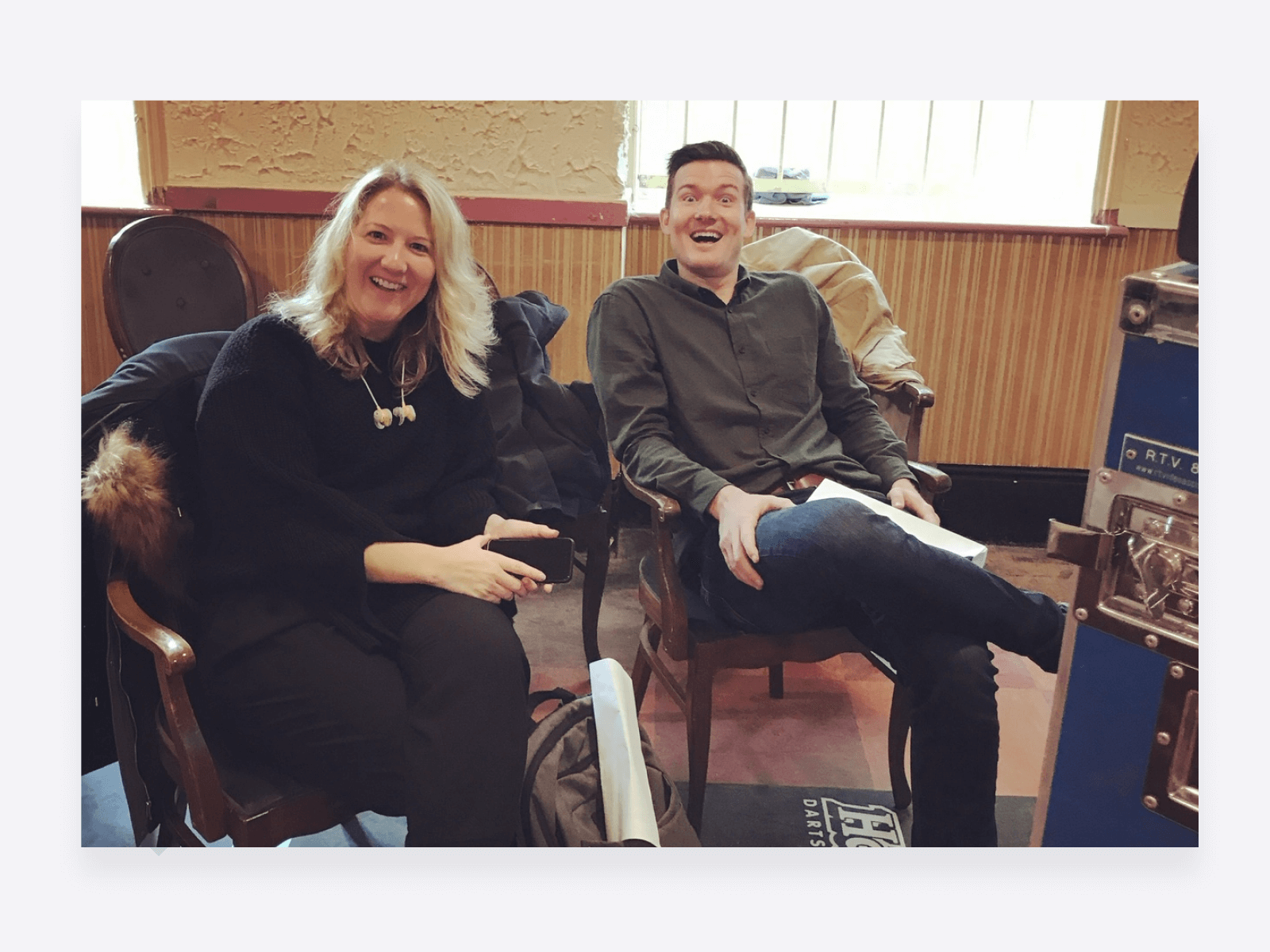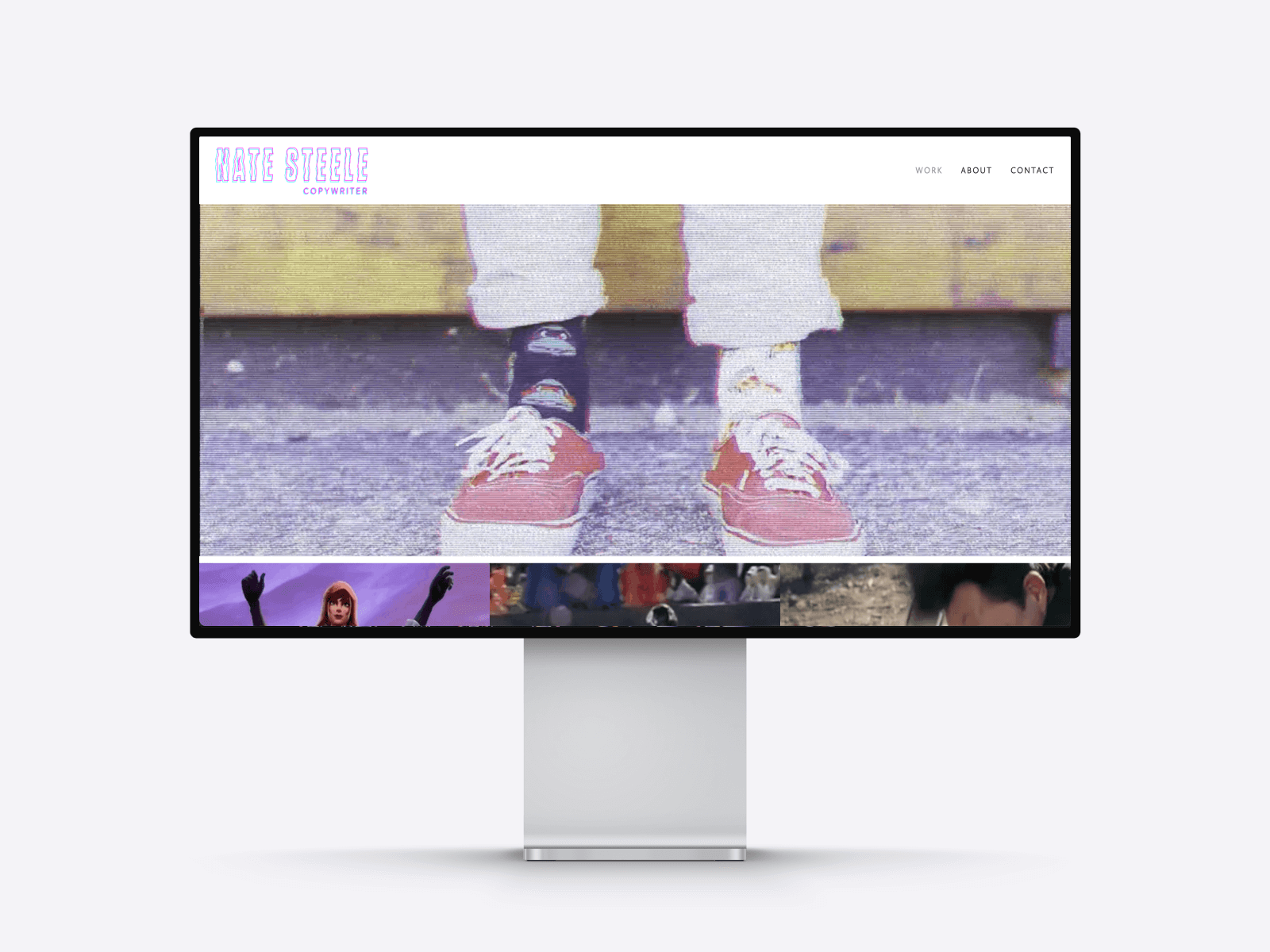DDB Creative Director Katie Bero on Portfolios: I Want to Hear Your Voice
Have you ever met a creative director with memes in her about page, writing scripts and comedy in her free time? Katie Bero is definitely not your average CD copywriter.
Yes, she graduated from Miami Ad School, started as an intern for Saatchi & Saatchi in London and is now a creative director at DDB in Chicago - ticking off all the boxes you’d expect from a successful and experienced copywriter in advertising. She’s also a brilliant creative and “wicked smart. Wicked funny.” as others praise her.
And she was kind enough to take time out of her busy schedule to chat to us about her career, work as a creative director and what they expect from copywriters applying to work in their team.

A screenshot of Katie's portfolio at katiebero.com
I read on your site that you moved around quite a lot as a kid. How did you decide where you want to settle and what you want to do?
I didn’t quite know when I finished college. I was in my last year and I wasn’t sure what I wanted to do. But I did an internship at an advertising agency and they suggested that I go to a portfolio school and do a copywriting program. I did that and with the school I went to, you can intern all around the world. I went to London and I interned there. Then I came to Chicago and I was offered a job through my internship. I have just been here ever since, it just worked out.
That’s really cool! And as you said you started working as a copywriter - but now you’re a creative director. How different is it work-wise?
There are some things that are the same because I’m still writing sometimes and I still work on projects. But I also now have teams that work under me, so my big responsibility is to make sure that they’re becoming the best writers that they can be. And that I’m helping them find their voice, instead of just becoming my voice. That’s been a big shift, mentoring and being responsible for the final product. Because at the end of the day, whatever happens with the work is on me.
And how does your team setup look like? You said you have teams that work under you.
Well, it kinda depends. I work on various brands, so it depends on how big the brand is. Sometimes we’ll have quite a few teams working under us. We can have between 5-10 teams if we’re working on a massive project. Or sometimes we just have one team working under us, if it’s a smaller project. So it kinda depends on what it is we’re doing.
I saw your portfolio and your projects - some are very touching, some super funny. Can you tell me about some of your favorite projects that you’ve done?
It’s funny because I like everything for different reasons. Like the State Farm “Don’t you” spot for the holidays. I love that spot because it was actually something that was intended to make a difference and make people come out and volunteer.
Anytime you can use your work to do something good in the world is an amazing opportunity.
But then, of course, I also like writing comedy. I love the State Farm football work, it was always so much fun to work with the players and create a little series. We almost treated it like a TV show, so I love that too.
But then I also love the KoolAid holiday video. That was something that had a very small budget. It was just a random idea that I wrote up and the client loved it. They gave us a couple thousand dollars, we went to the prop house, created the entire set and shot it ourselves. That was just a fun experience. You don’t have to have millions of dollars to make it work.
Yes, definitely! And what’s your creative process? How does it look like when you get hired on a project?
Usually, it starts with the creative brief. Our strategist will give us an insight and then my art director partner and I will just go and start thinking. Usually, we’ll spend a couple of days just sitting across from each other, kind of in silence. And then every once in a while one of us will have a thought. And once we land on whatever the big idea is, I’ll go off and write a bunch of scripts. Then we present them and hopefully get something in the mix.
You say you and your art director partner. Do you still have an art director partner as a creative director?
Yes. We still work together, we still creative direct everything together. We’ve been partners for 7 years now. It works great. Being in the creative director role, having a partner is really helpful because if we have multiple projects going on, we can divide and conquer. And he’s an art director, but he has opinions on writing too and I really value that. It’s always nice to have more creative opinions in the room.

Katie with her art director partner
That’s really interesting - I always thought that once you become a creative director, you’re all alone, without a partner.
Yes, some people do that. I would say it’s probably a 50/50 split of people who stay in their team and who go on their own. I think it also depends on how many brands you’re running. You can choose your adventure, how you wanna do it.
As you said, mentoring and leading others is a part of your job now. Do you also take part in hiring copywriters or choosing who to get on your team?
Yes. I will usually see a bunch of copywriting portfolios and if anything stands out, we will set up an interview and have a chat with them.
And when you’re looking at the portfolios, what are the skills you’re looking for? What are the important skills for someone to become a copywriter?
Really, I’m just looking for their voice. I want to see your voice coming through in everything. I don’t expect, especially for somebody that’s starting out, a very polished portfolio. You don’t have to have perfect execution, I just want to see really sharp writing.
I want to see a consistent voice where I can really understand what makes you unique and different. And I think that’s a big thing too. Even besides just your writing, it’s about showing me what makes you who you are, what your background is - showing that to me in a unique way.
And how do you think they can do that in a portfolio?
For a writer, I think it’s just how you write it. That’s your voice. It’s maybe not being too precious about it and overthinking it. Just say it the way you would say it. You don’t have to worry about being overly professional.
I mean, if you look at my creative director portfolio, I’ve got memes in there and stuff like that. I want to see your personality and I want to hear your voice. I think that’s the most important thing.
And in general, is it important for copywriters to have a portfolio at all?
Yeah, absolutely. That’s really the only way I can tell if you can write. I need to see it. There are a lot of people in the world who say “I wanna be a writer”, but they never do the due diligence of sitting down and actually writing. The portfolio is definitely your key to entry.

Katie running lines at the filming of a State Farm commercial
I actually heard from someone that nowadays portfolio schools don’t focus enough on the craft of writing, but they focus more on the big ideas… Have you had any experience with that?
Most definitely. I think that is a huge issue for people who want to become copywriters. Because it’s craft craft craft. At the end of the day, you need to be able to write. Obviously, we wanna see big ideas too. But if there’s no great copy in it, I don’t know why to hire you as a writer.
So I tell all young writers: just focus on your writing.
And when we look at the format and content of the portfolios, what do you think makes a good portfolio? How do you expect it to look like?
I don’t really have a template of what I expect it to look like. I always enjoy a surprise when I see something that I haven’t seen. I think it’s really easy to go down a rabbit hole, looking at a lot of portfolios and trying to copy them.
But I think the best thing you can do is stand out. Even if it’s not an advertising piece. If you like funny poems, put those in there, I love seeing things like that. If you like writing short stories, throw those in there, I’ll read those. Those are almost more important to me than the advertising pieces.
Don’t you think those would clutter up the portfolio? Do you actually have time to read those?
If it’s a portfolio I’m really interested in, I will read those. And especially if someone has taken the time to put it in there, then I assume they put it in there for a reason. And that it shows off something about their voice that’s important to them. So I will take the time.
And is there anything that you don’t like to see in portfolios? Any typical mistakes or something annoying that you keep encountering?
One thing that I don’t encourage people to do is to try to create ads for brands like Nike. Don’t go do Nike ads. Nike makes some of the most famous work in the world. Whatever you come up with is probably not going to be better than that.
So I just really encourage people starting out to find a brand nobody’s doing good work for. Try to come up with a great idea for that. Do Q-tips or tissues! Or maybe there’s a local brand that only you know about.
But don’t try to do the brands that are doing the best work in the world.
So when someone is starting out and they don’t have a lot of real experience… Do you mind if some of their projects are made up or for small local companies?
Absolutely not. When you’re starting out, the whole thing can be made up. I don’t expect you to have real brand work. I see it as almost like your student portfolio and that’s perfectly fine.
And do you usually focus on hiring juniors or have you looked at senior copywriters too?
It’s across the board, everything from juniors to associate creative directors.
I was just wondering if there were different expectations for the portfolios of let’s say a senior copywriter versus a total beginner.
Absolutely. I mean, a junior copywriter… It’s almost like “the world is your oyster”, you can literally put anything you want in there. I almost want you to go crazy and be irresponsible with your ideas. Because that’s what juniors bring to the table. They’re not jaded yet by reality. I just love a crazy junior portfolio.
But then for more seasoned senior copywriters, you need to have some real work that’s been produced and made. I don’t need to see a ton of it, but I need to see your best. So it really becomes the difference between having had production experience and just showing me that you have potential.
Is there anything else you would like to share regarding copywriting, the creative process or portfolios?
The one thing I would say is that there’s no magical formula and everybody’s different. I always encourage everybody to be yourself and never try to fit into any kinda mould. I think that’s what’s going to make you the best copywriter you can be, so you’re successful.
Thank you for the interview, Katie!
Check out Katie’s website at katiebero.com or connect with her on LinkedIn!
Build your own copywriter portfolio with Copyfolio!
If you're looking for a quick and easy way to build a copywriter portfolio website, you should check out Copyfolio. It takes away the intimidating design and coding decisions of website building and lets you create a stunning site in a matter of minutes.
Choose a template, fill your pages with copy, add your projects & you're done. One-click mockups will help your frame your images professionally, while global color palettes and font presets make it easy to change the look of your site in a second.
Get started for free and create your copywriter portfolio today!



